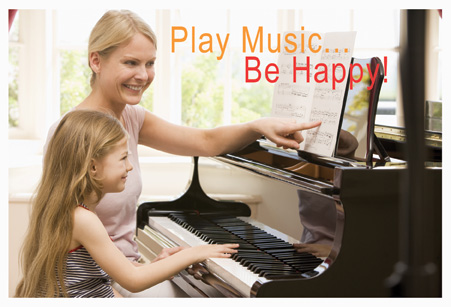An Overview
Ages of students | 4 to 6 year olds |
Course length | 2 years |
Class schedule | One class per week |
Parent participation | Required (participation enables parent to be an effective “at home” learning partner) |
Curriculum | The in-class musical experiences nurture creativity and help instill the basis for playing and expression through feeling and understanding music. |

Lesson Contents Include
Hearing
Listening to wonderful music helps children:
- Develop emotional sensitivity
- Correct tempo, rhythm, and pitch
- Feel and express music in time rhythmically
Playing
Performing songs introduces children to the joy of expressing music by themselves. Playing also helps students:
- Get familiar with the five-line staff and keyboard
- Express music with both hands
Singing
Children love to sing! Singing develops:
- Self expression
- Develop an ear for music
- Understanding of note names
Creating
Junior Music Course experiences cultivate children’s:
- Musical creativity
- Sense of harmony
Why Yamaha Music Education System is Effective?
Yamaha teachers are dedicated…
During these music lessons for children teachers are also eager to work with young children and parents. Committed to providing happy, rewarding first musical experiences, these college-trained musicians and educators have passed demanding tests in musicianship while completing rigorous training prior to certification by the Yamaha Music Education System.
Upon completion of the Course
Once your child has completed the Junior Music Course, he or she will take part in a “Fundamental Skills Survey” to confirm his or her musical achievement. Teachers refer to Survey results to correctly place students in advanced courses of study such as the Junior Extension Course and Junior Special Advanced Course. As the children develop more advanced musical skills, they are also encouraged to express themselves by performing and composing their own music through programs like Junior Original Concert.
An international music education system…
When you enroll your child in the Junior Music Course, you are assured of an excellent first course of musical study. Yamaha has invested over 30 years of music education research in the United States, Japan, Canada, and dozens of other countries. More than four million children and adult students have graduated from Yamaha courses worldwide.
Nurturing Creativity in a Relaxed Manner
Underlying Yamaha’s music education system are three concepts: Timely Education, Group Lessons and Emphasis on Creativity.
Timely Education
In order for children to enjoy music and to absorb and understand the given material easily, we believe it is best to give them appropriate guidance in accordance with the degree of their physical and mental development.
Based upon this concept of timely education, the Junior Music Course introduces 4-to 6-year olds to music fundamentals at the time when their hearing capabilities are rapidly developing. Other Yamaha children’s courses also fit the concept of timely education.
Group Lessons
Group lessons have many advantages that enable children enjoy rich musical experiences such as making friends through music, developing cooperativeness and deepening understanding of music through participation in ensembles.
For this purpose, Yamaha has adopted a method whereby students can listen and play in a group, learning music while enjoying it.
Emphasis on Creativity
In order to enable students to develop their creative capabilities, it is important to help them develop the ability to express themselves by thinking freely. We hope to help them acquire and enhance sensitivity and imagination, which are both sources of creativity, through our comprehensive system of music education.
Junior Music Course (JMC) (for 4 to 6-year-olds)
This course is the foundation of the entire Yamaha Music School. Because this is the period when children’s hearing sense develops most remarkably, we offer two-year group lesson. Each group consists of about 8 students, with the primary objective being to enable them to acquire a sense of pitch as well as the ability to identify sounds. The children learn the three basic elements of music: rhythm, melody and harmony, through hearing, singing and playing. The course develops their basic capabilities to enjoy music in a free and easy manner.
